沪教版六年级英语上册全册教案【2019】
- 格式:docx
- 大小:197.53 KB
- 文档页数:92
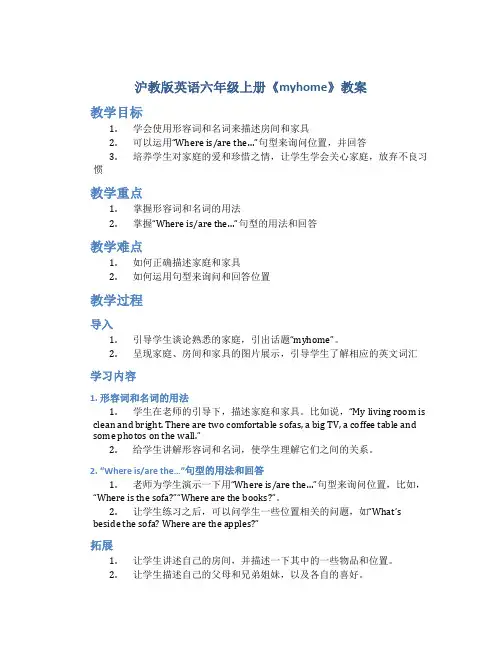
沪教版英语六年级上册《myhome》教案教学目标1.学会使用形容词和名词来描述房间和家具2.可以运用“Where is/are the…”句型来询问位置,并回答3.培养学生对家庭的爱和珍惜之情,让学生学会关心家庭,放弃不良习惯教学重点1.掌握形容词和名词的用法2.掌握“Where is/are the…”句型的用法和回答教学难点1.如何正确描述家庭和家具2.如何运用句型来询问和回答位置教学过程导入1.引导学生谈论熟悉的家庭,引出话题“myhome”。
2.呈现家庭、房间和家具的图片展示,引导学生了解相应的英文词汇学习内容1. 形容词和名词的用法1.学生在老师的引导下,描述家庭和家具。
比如说,“My living room is clean and bright. There are two comfortable sofas, a big TV, a coffee table and some photos on the wall.”2.给学生讲解形容词和名词,使学生理解它们之间的关系。
2. “Where is/are the…”句型的用法和回答1.老师为学生演示一下用“Where is/are the…”句型来询问位置,比如,“Where is the sofa?”“Where are the books?”。
2.让学生练习之后,可以问学生一些位置相关的问题,如“What’s beside the sofa? Where are the apples?”拓展1.让学生讲述自己的房间,并描述一下其中的一些物品和位置。
2.让学生描述自己的父母和兄弟姐妹,以及各自的喜好。
3.可以引导学生写一篇小短文,介绍自己心中的完美家庭,并描述其中的各个部分。
教学总结1.形容词和名词是描述家庭和家具的重要词汇;2.“Where is/are the…”句型可用于询问位置,需要了解句子结构;3.学习英语,有关家庭和爱的情感都是不可或缺的内容。
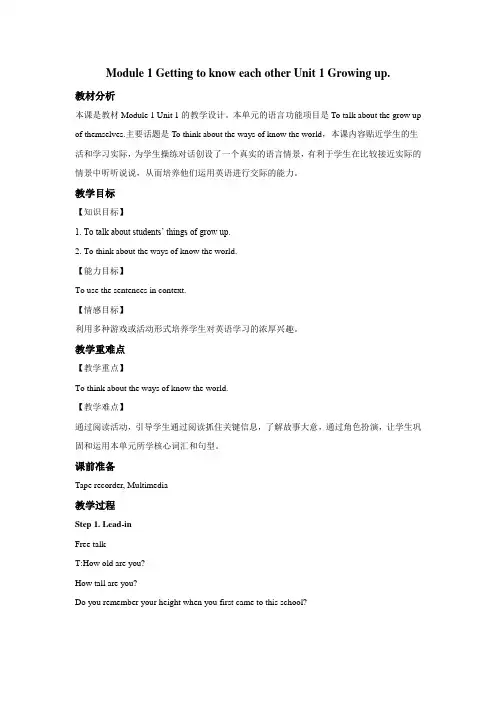
Module 1 Getting to know each other Unit 1 Growing up.教材分析本课是教材Module 1 Unit 1的教学设计。
本单元的语言功能项目是To talk about the grow up of themselves.主要话题是To think about the ways of know the world,本课内容贴近学生的生活和学习实际,为学生操练对话创设了一个真实的语言情景,有利于学生在比较接近实际的情景中听听说说,从而培养他们运用英语进行交际的能力。
教学目标【知识目标】1. To talk about students’ things of grow up.2. To think about the ways of know the world.【能力目标】To use the sentences in context.【情感目标】利用多种游戏或活动形式培养学生对英语学习的浓厚兴趣。
教学重难点【教学重点】To think about the ways of know the world.【教学难点】通过阅读活动,引导学生通过阅读抓住关键信息,了解故事大意,通过角色扮演,让学生巩固和运用本单元所学核心词汇和句型。
课前准备Tape recorder, Multimedia教学过程Step 1. Lead-inFree talkT:How old are you?How tall are you?Do you remember your height when you first came to this school?Step 2. Listen and readPlay the tape for students to listen and answer.Ask the students to listen to the comic strips and answer the following questions:1.What is on Eddie’s mind?2.Will Eddie build his house by himself?Step 3. PresentationT:You are growing older and taller, so ,you are growing up.What comes into your mind when talking about “growing up”?Encourage the students to talk about the words or sentences about “growing up”?Q: Do you feel happy to grow up?Do you want to grow up?Teacher says: Just like what Eddie said,“Growing up is hard.”Growing up also means that you learn more about the world.How do you learn about the world?Show them some pictures to encourage the students to say out the full sentences and finish Part A.Step 4. PracticeListen to part B.Ask: How does Mill learn about the world? Why?How does Simon learn about the world? Why?Work in pairs to practice the dialogue.Sample conversation :S1:How do you learn about the world?S2:I like to learn about the world from films.S1:Why do you like to learn that way?S2:Because I can see...Step 5. SummaryDiscussion: What have we learned in this class?Show time.1.on one’s mind.2.be worried about(doing).3.Growing up is hard.4.You have been happy since I first met you.5.wake sb. up.6.learn that way.7.through the Internet.8.as soon as.9.a great deal of.Step 6. HomeworkRevise the contents we’ve learned in this period .Recite the comic strip fluently .Finish exercises in workbook for each period.Unit 2 My summer holiday【第一课时】【教学目标】1.帮助学生学习Look and learn中的生词。
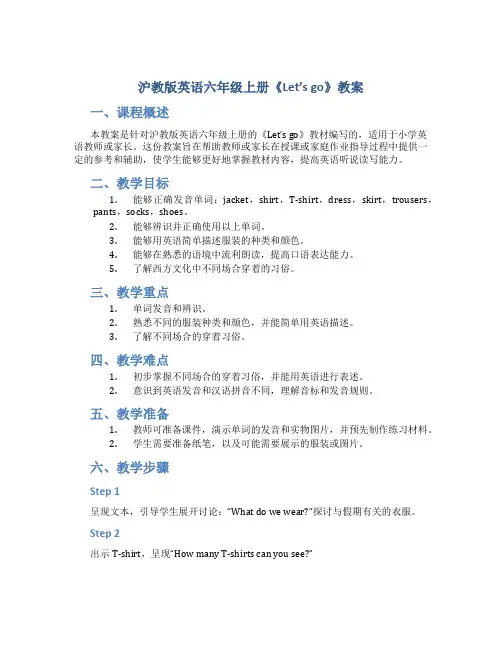
沪教版英语六年级上册《Let’s go》教案一、课程概述本教案是针对沪教版英语六年级上册的《Let’s go》教材编写的,适用于小学英语教师或家长。
这份教案旨在帮助教师或家长在授课或家庭作业指导过程中提供一定的参考和辅助,使学生能够更好地掌握教材内容,提高英语听说读写能力。
二、教学目标1.能够正确发音单词:jacket,shirt,T-shirt,dress,skirt,trousers,pants,socks,shoes。
2.能够辨识并正确使用以上单词。
3.能够用英语简单描述服装的种类和颜色。
4.能够在熟悉的语境中流利朗读,提高口语表达能力。
5.了解西方文化中不同场合穿着的习俗。
三、教学重点1.单词发音和辨识。
2.熟悉不同的服装种类和颜色,并能简单用英语描述。
3.了解不同场合的穿着习俗。
四、教学难点1.初步掌握不同场合的穿着习俗,并能用英语进行表述。
2.意识到英语发音和汉语拼音不同,理解音标和发音规则。
五、教学准备1.教师可准备课件,演示单词的发音和实物图片,并预先制作练习材料。
2.学生需要准备纸笔,以及可能需要展示的服装或图片。
六、教学步骤Step 1呈现文本,引导学生展开讨论:“What do we wear?”探讨与假期有关的衣服。
Step 2出示T-shirt,呈现“How many T-shirts can you see?”Step 3引导学生回忆上课学习的字母和音标。
然后,教师出示PPT或幻灯片,提示学生发音并模仿。
如:jacket,shirt,dress,skirt等。
Step 4展示“Colour your clothes”,提供练习机会,呈现式样,并要求填写各种颜色。
Step 5提出问题,“What color is your T-shirt?”学生用英语描述他们的衣服的颜色。
Step 6展示图片,教师问,“What do you like to wear?”或“Can you see what clothes they wear?”学生用英语表述自己喜欢穿的衣服或其他人穿的衣服。
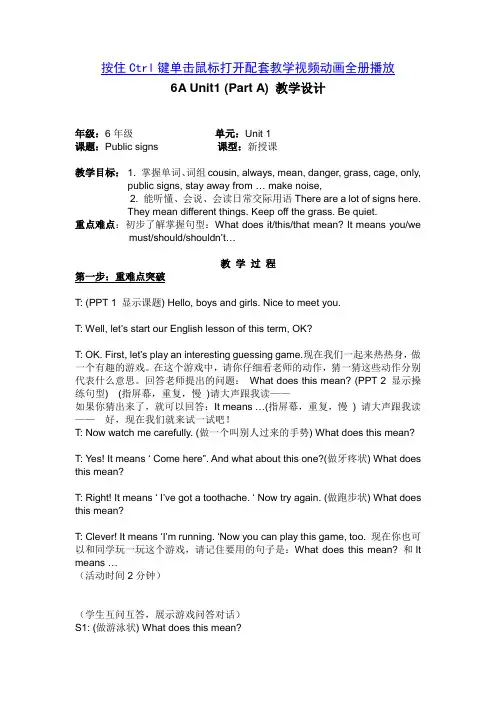
按住Ctrl键单击鼠标打开配套教学视频动画全册播放6A Unit1 (Part A) 教学设计年级:6年级单元:Unit 1课题:Public signs 课型:新授课教学目标: 1. 掌握单词、词组cousin, always, mean, danger, grass, cage, only, public signs, stay away from … make noise,2. 能听懂、会说、会读日常交际用语There are a lot of signs here.They mean different things. Keep off the grass. Be quiet.重点难点:初步了解掌握句型:What does it/this/that mean? It means you/we must/should/shouldn’t…教学过程第一步:重难点突破T: (PPT 1 显示课题) Hello, boys and girls. Nice to meet you.T: Well, let’s start our English lesson of this term, OK?T: OK. First, let’s play an interesting guessing game.现在我们一起来热热身,做一个有趣的游戏。
在这个游戏中,请你仔细看老师的动作,猜一猜这些动作分别代表什么意思。
回答老师提出的问题:What does this mean? (PPT 2 显示操练句型) (指屏幕,重复,慢)请大声跟我读——如果你猜出来了,就可以回答:It means …(指屏幕,重复,慢) 请大声跟我读——好,现在我们就来试一试吧!T: Now watch me carefully. (做一个叫别人过来的手势) What does this mean?T: Yes! It means ‘ Come here”. And what about this one?(做牙疼状) What does this mean?T: Right! It means ‘ I’ve got a toothache. ‘ Now try again. (做跑步状) What does this mean?T: Clever! It means ‘I’m running. ‘Now you can play this game, too. 现在你也可以和同学玩一玩这个游戏,请记住要用的句子是:What does this mean? 和It means …(活动时间2分钟)(学生互问互答,展示游戏问答对话)S1: (做游泳状) What does this mean?S2: It means ’swim ”.S1: (做快速游泳状) What does this mean?S2: It means ’swim fast ”.S3: (做停止手势) What does this mean?S4: It means ’Stop ”.S4: (竖起大拇指) What does this mean?S3: It means ’Great ”.T: They did a good job. What about you? 你呢?(本步骤设计说明:本节课课文对话生词较多,对话中反复出现新句型What does it mean? It means … 学生感觉比较陌生,在理解时会产生困难。
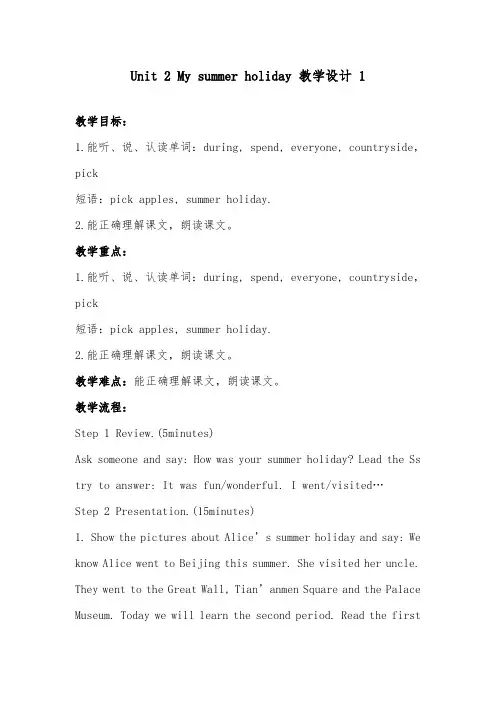
Unit 2 My summer holiday 教学设计 1教学目标:1.能听、说、认读单词:during, spend, everyone, countryside,pick短语:pick apples, summer holiday.2.能正确理解课文,朗读课文。
教学重点:1.能听、说、认读单词:during, spend, everyone, countryside,pick短语:pick apples, summer holiday.2.能正确理解课文,朗读课文。
教学难点:能正确理解课文,朗读课文。
教学流程:Step 1 Review.(5minutes)Ask someone and say: How was your summer holiday? Lead the Ss try to answer: It was fun/wonderful. I went/visited…Step 2 Presentation.(15minutes)1. Show the pictures about Alice’s summer holiday and say: We know Alice went to Beijing this summer. She visited her uncle. They went to the Great Wall, Tian’anmen Square and the Palace Museum. Today we will learn the second period. Read the firstpassage and find the new word:enjoy 享受 enjoy her summer holiday 享受她的暑假Read and remember the words and phrases.Read the passage in groups, then read yourselves. Ask someone read in class.2. Read the second passage and find the new words and phrases: during 在…期间 during the summer holiday 在暑假期间the UK= the United Kingdom 英国 go back to some place 返回某地spend 度过 spend their holiday 度过他们的假期Big Ben 大本钟 the British Museum 大英博物馆have a good time 玩得开心,过得快乐 everyone 每个人,所有人Read in groups. Then try to remember.Read the passage in groups, then ask someone to read in class.3. Learn the third passage using the same way. The new words and phrases:Stay 停留,呆 stay with sb. 和某人呆在一起 pick apples 摘苹果 countryside 乡村,农村 in the countryside 在农村Read the passage for several times.Step 3 Cooperation.(10minutes)Read and remember the important words and phrases.Read the text.Try to finish the exercises.Step 4 Show.(5minutes)I can read and remember the important words and phrases.I can read the text.。
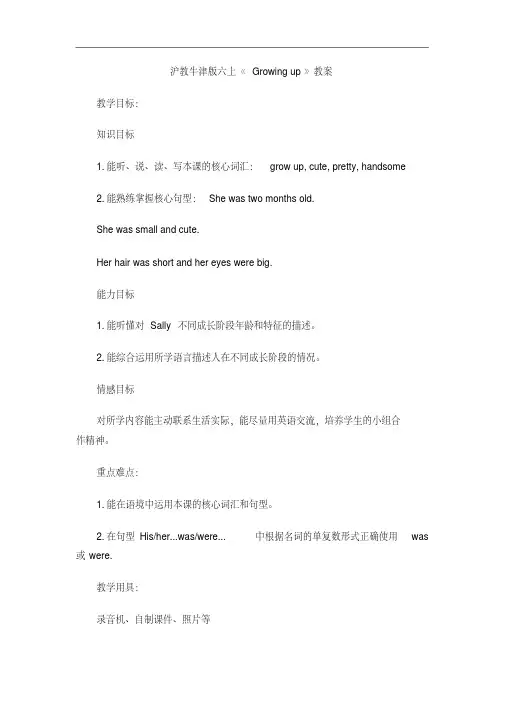
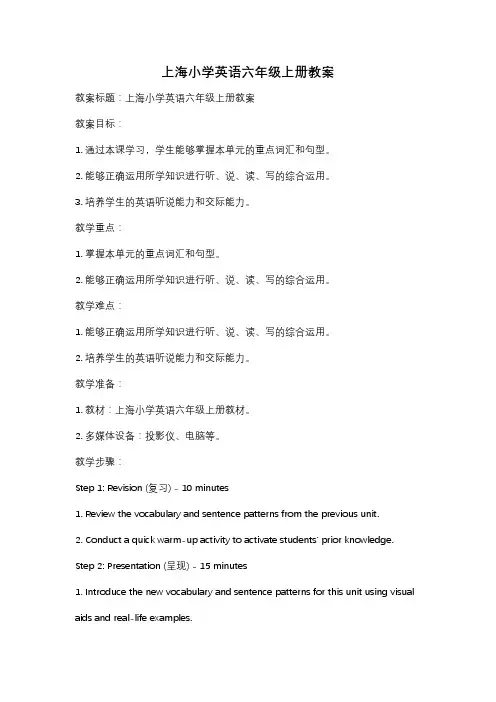
上海小学英语六年级上册教案教案标题:上海小学英语六年级上册教案教案目标:1. 通过本课学习,学生能够掌握本单元的重点词汇和句型。
2. 能够正确运用所学知识进行听、说、读、写的综合运用。
3. 培养学生的英语听说能力和交际能力。
教学重点:1. 掌握本单元的重点词汇和句型。
2. 能够正确运用所学知识进行听、说、读、写的综合运用。
教学难点:1. 能够正确运用所学知识进行听、说、读、写的综合运用。
2. 培养学生的英语听说能力和交际能力。
教学准备:1. 教材:上海小学英语六年级上册教材。
2. 多媒体设备:投影仪、电脑等。
教学步骤:Step 1: Revision (复习) - 10 minutes1. Review the vocabulary and sentence patterns from the previous unit.2. Conduct a quick warm-up activity to activate students' prior knowledge. Step 2: Presentation (呈现) - 15 minutes1. Introduce the new vocabulary and sentence patterns for this unit using visual aids and real-life examples.2. Provide explanations and examples to ensure students understand the meaning and usage of the new language items.Step 3: Practice (练习) - 20 minutes1. Conduct various listening and speaking activities to practice the new vocabulary and sentence patterns.2. Use pair work or group work to encourage students to interact and communicate in English.3. Provide feedback and correction during the practice activities to help students improve their language skills.Step 4: Reading and Writing (阅读和写作) - 20 minutes1. Assign reading tasks from the textbook or supplementary materials.2. Guide students to read and comprehend the text, and then answer comprehension questions.3. Engage students in writing activities related to the reading text, such as summarizing, writing a dialogue, or creating a story.Step 5: Consolidation (巩固) - 10 minutes1. Review the key points covered in this lesson.2. Conduct a short quiz or game to assess students' understanding and retention of the new language items.Step 6: Homework (作业) - 5 minutesAssign relevant exercises or tasks as homework to reinforce the learning from the lesson.教学建议和指导:1. 在教学过程中,要尽量创造多样化的活动形式,如游戏、角色扮演、小组合作等,以激发学生的学习兴趣和积极性。
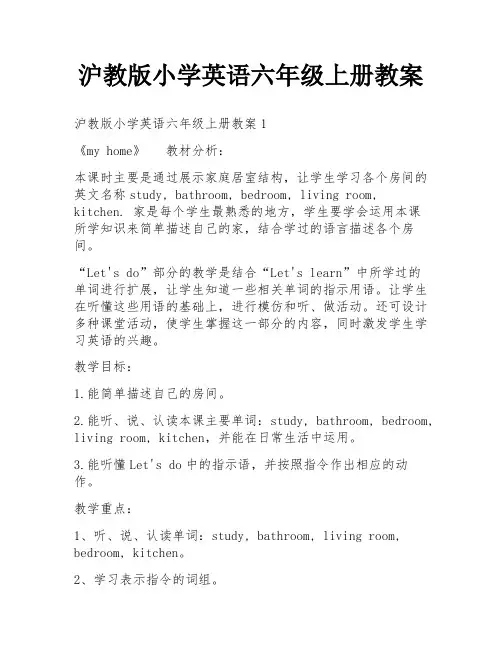
沪教版小学英语六年级上册教案沪教版小学英语六年级上册教案1《my home》教材分析:本课时主要是通过展示家庭居室结构,让学生学习各个房间的英文名称study, bathroom, bedroom, living room, kitchen. 家是每个学生最熟悉的地方,学生要学会运用本课所学知识来简单描述自己的家,结合学过的语言描述各个房间。
“Let's do”部分的教学是结合“Let's learn”中所学过的单词进行扩展,让学生知道一些相关单词的指示用语。
让学生在听懂这些用语的基础上,进行模仿和听、做活动。
还可设计多种课堂活动,使学生掌握这一部分的内容,同时激发学生学习英语的兴趣。
教学目标:1.能简单描述自己的房间。
2.能听、说、认读本课主要单词:study, bathroom, bedroom, living room, kitchen,并能在日常生活中运用。
3.能听懂Let's do中的指示语,并按照指令作出相应的动作。
教学重点:1、听、说、认读单词:study, bathroom, living room, bedroom, kitchen。
2、学习表示指令的词组。
教学难点:单词study, bathroom, bedroom的发音。
教学方法:引导法启发法直观教学法学法分析:小组合作学习法讨论学习法自主学习法教学过程:1 Warm-up/Revision教师引导1、集体唱英文儿歌。
2、复习上节课所学单词2 Presentation1、出示study 的图片,手指着书房里的书问学生:What are they? 教读单词 study, 并板书。
教师用动作帮助学生理解词义:We read the books in the study.2、按照相同方法,教授单词 bathroom, living room, bedroom.3、师把第46页Let’s learn部分的挂图贴到黑板上说:This is my home. How many rooms can you see? What are they?4、教师说指令。
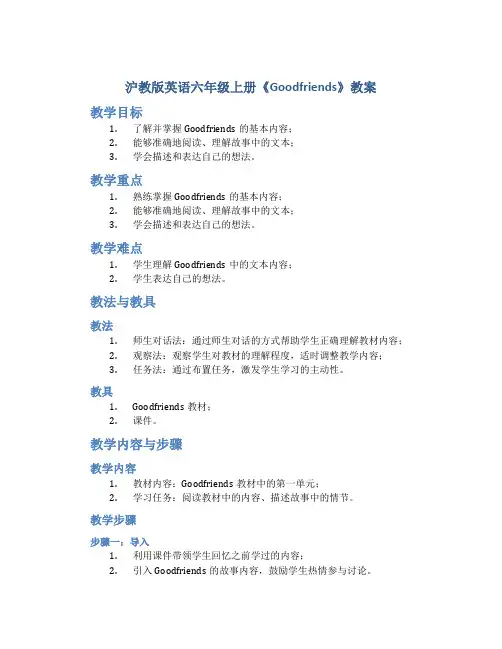
沪教版英语六年级上册《Goodfriends》教案教学目标1.了解并掌握Goodfriends的基本内容;2.能够准确地阅读、理解故事中的文本;3.学会描述和表达自己的想法。
教学重点1.熟练掌握Goodfriends的基本内容;2.能够准确地阅读、理解故事中的文本;3.学会描述和表达自己的想法。
教学难点1.学生理解Goodfriends中的文本内容;2.学生表达自己的想法。
教法与教具教法1.师生对话法:通过师生对话的方式帮助学生正确理解教材内容;2.观察法:观察学生对教材的理解程度,适时调整教学内容;3.任务法:通过布置任务,激发学生学习的主动性。
教具1.Goodfriends教材;2.课件。
教学内容与步骤教学内容1.教材内容:Goodfriends教材中的第一单元;2.学习任务:阅读教材中的内容、描述故事中的情节。
教学步骤步骤一:导入1.利用课件带领学生回忆之前学过的内容;2.引入Goodfriends的故事内容,鼓励学生热情参与讨论。
步骤二:阅读理解1.向学生播放视频或读取文本,让学生全面了解故事情节;2.师生互动:通过师生对话的方式让学生更深入地理解故事内容;3.学生个人阅读:让学生自主阅读故事,加深理解。
步骤三:情境交际1.师生互动:通过师生对话的方式,帮助学生描述故事中的情境;2.任务布置:让学生分组讨论再现故事情节。
步骤四:总结1.总结本堂课教学内容;2.布置下节课内容。
课后作业1.找出自己喜欢的一段Goodfriends中的文本,并通过语音或者视频的方式朗读出来;2.通过互联网查找相关资料,了解中西式早餐的差异。
随堂测试1.请描述Goodfriends中故事情节的主要内容;2.梳理故事情节,画出思维导图。
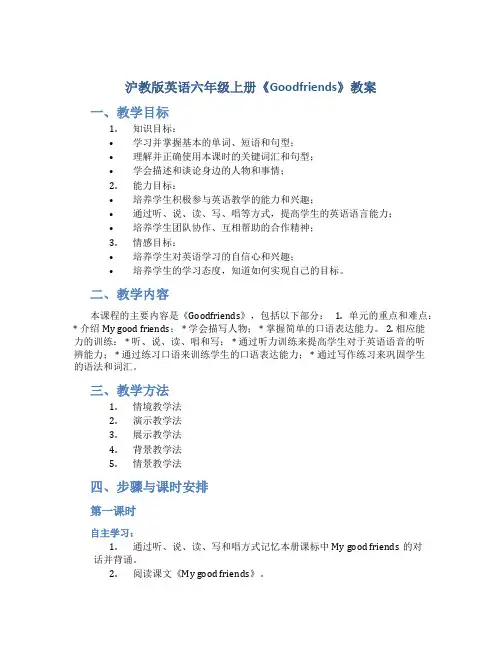
沪教版英语六年级上册《Goodfriends》教案一、教学目标1.知识目标:•学习并掌握基本的单词、短语和句型;•理解并正确使用本课时的关键词汇和句型;•学会描述和谈论身边的人物和事情;2.能力目标:•培养学生积极参与英语教学的能力和兴趣;•通过听、说、读、写、唱等方式,提高学生的英语语言能力;•培养学生团队协作、互相帮助的合作精神;3.情感目标:•培养学生对英语学习的自信心和兴趣;•培养学生的学习态度,知道如何实现自己的目标。
二、教学内容本课程的主要内容是《Goodfriends》,包括以下部分: 1. 单元的重点和难点:* 介绍My good friends; * 学会描写人物; * 掌握简单的口语表达能力。
2. 相应能力的训练: * 听、说、读、唱和写; * 通过听力训练来提高学生对于英语语音的听辨能力; * 通过练习口语来训练学生的口语表达能力; * 通过写作练习来巩固学生的语法和词汇。
三、教学方法1.情境教学法2.演示教学法3.展示教学法4.背景教学法5.情景教学法四、步骤与课时安排第一课时自主学习:1.通过听、说、读、写和唱方式记忆本册课标中My good friends的对话并背诵。
2.阅读课文《My good friends》。
家庭作业:1.熟读课文;2.了解单词及短语的意思;3.正确朗读对话,并背诵。
第二课时教师示范:1.以本册课标的对话为引导,由教师向学生介绍描写人物的方法。
2.在讲述时,教师应注重以下几方面:•感性的描述,引起学生的兴趣;•了解学生的语言水平,并根据学生的表现有所调整;•了解学习目标,有有效的策略。
学生练习:1.以课标的对话为基础,让学生在小组内进行描写人物的练习;2.通过组内合作,让学生提高口语表达能力;3.鼓励学生互相交流,互相帮助,提高团队协作的精神。
家庭作业:1.整理今日的学习内容,做好笔记;2.练习口语表达。
第三课时家庭作业讲解:1.进行朗读口语表达训练;2.讲解疑问句的语法。
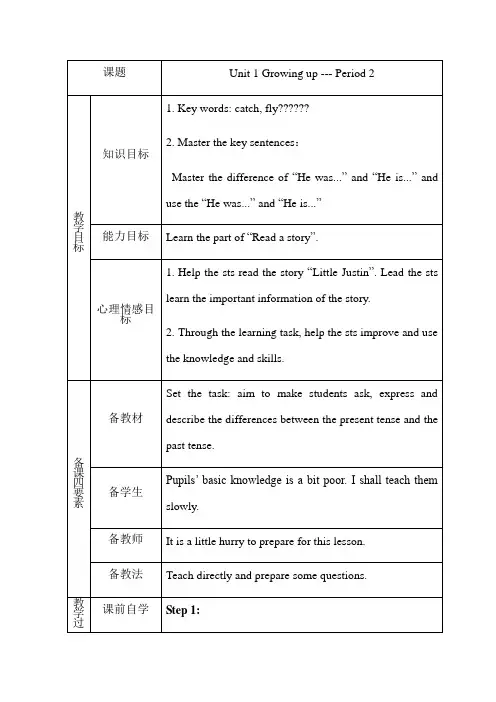
六年级上册英语教案上海版教案标题:六年级上册英语教案(上海版)教学目标:1. 通过本节课的学习,学生将能够掌握并正确使用以下词汇:weather, sunny, cloudy, rainy, snowy, windy, hot, cold, warm。
2. 学生能够描述不同的天气情况,并能够用英语进行简单的天气预报。
3. 学生通过听、说、读、写等多种方式,培养英语语言运用能力,提高听说能力。
教学重点:1. 掌握与天气相关的词汇。
2. 学会描述不同的天气情况。
3. 进行简单的天气预报。
教学准备:1. 多媒体设备。
2. 单词卡片或图片,用于引导学生学习新词汇。
3. 天气图表或图片,用于进行天气预报的练习。
4. 学生练习册和笔。
教学过程:Step 1: Warm-up (热身活动)1. 利用多媒体或图片,向学生展示不同的天气情况,并帮助学生用英语表达出来。
2. 引导学生回忆并复习之前学过的天气词汇,如sunny, cloudy, rainy等。
Step 2: Presentation (呈现新知识)1. 准备单词卡片或图片,依次展示weather, sunny, cloudy, rainy, snowy, windy, hot, cold, warm等词汇,帮助学生正确发音并理解词义。
2. 引导学生进行跟读和模仿练习,确保学生能够正确运用这些词汇。
Step 3: Practice (练习)1. 利用天气图表或图片,向学生展示不同的天气情况,并要求学生用英语进行描述。
例如:It's sunny today.(今天是晴天。
)2. 分组活动:将学生分成小组,每个小组选择一个天气情况,进行小组内的天气预报练习。
其中一名学生扮演天气预报员,其他学生扮演观众,预报员用英语描述天气情况,观众猜测具体的天气是什么。
Step 4: Production (输出)1. 要求学生根据所学的天气词汇,用英语写一篇简短的天气预报。
沪教版六年级英语上册教学计划一、教学目标设定针对六年级学生的英语学习,我们设定以下教学目标:1.语言知识:掌握课本中的基础词汇、短语、句型和语法知识,能够理解和运用所学内容。
2.语言技能:培养学生的听说读写能力,能够使用英语进行简单的日常交流和书面表达。
3.学习策略:引导学生形成有效的英语学习策略,提高自主学习能力。
4.文化意识:增进学生对英语国家文化的了解,培养跨文化交际能力。
二、教学内容概览本册教材主要包括以下单元:1.Unit 1: 学校生活2.Unit 2: 节假日与活动3.Unit 3: 健康与身体4.Unit 4: 自然环境5.Unit 5: 科技与未来每个单元都包含对话、词汇、语法、阅读、写作等部分,旨在全面提升学生的英语能力。
三、教学重点难点1.2.教学重点:o基础词汇和短语的掌握o基本语法知识的理解和运用o听说读写技能的培养3.4.教学难点:o语法知识的综合运用o英语口语表达能力的提高o英语写作技能的培养四、教学方法与手段1.情境教学法:通过模拟真实情境,让学生在情境中学习英语,提高语言应用能力。
2.互动式教学:鼓励学生积极参与课堂互动,提高课堂参与度。
3.任务型教学:布置具有挑战性的任务,让学生在完成任务的过程中学习英语。
4.多媒体教学:利用教学软件、动画、视频等多媒体资源辅助教学,提高学生的学习兴趣和效率。
五、教学时间安排本册教材计划用一学期(约20周)的时间完成。
每个单元的教学时间约为4周,包括新课教学、复习和测试等环节。
六、学生评价方式1.课堂表现评价:观察学生的课堂表现,包括参与度、回答问题等,给予及时反馈。
2.作业评价:定期检查学生的作业完成情况,了解学生对课堂知识的掌握情况。
3.单元测验:每个单元结束后进行测验,评估学生的学习效果,发现问题及时调整教学策略。
4.期末考试:学期末进行综合性考试,全面评估学生的英语能力。
七、教学资源准备1.教材及配套练习册2.英语教学软件、动画、视频等多媒体资源3.教具与实物,如图片、卡片、实物模型等4.英语学习网站、在线词典等网络资源八、教学总结与反思在每个单元和学期结束时,教师应对教学过程进行总结与反思,评估教学目标是否达成,教学方法是否有效,学生是否存在普遍性问题等。
沪教版六年级英语上册教学计划一、教学目标设定针对沪教版六年级英语上册,我们的教学目标是:1.语言知识:巩固和拓展学生的基础词汇和语法知识,提高语言运用的准确性。
2.语言技能:提高学生的听、说、读、写能力,特别是阅读和写作技能,以适应更高层次的学习需求。
3.学习策略:培养学生自主学习和合作学习的能力,形成良好的学习策略。
4.文化意识:增强学生的跨文化交际能力,提高对英语国家文化的理解。
二、教学内容概览本册教材主要包括以下内容:1.词汇:学习并巩固与日常生活、学校生活、社会活动等相关的词汇。
2.语法:系统学习并练习现在完成时、一般过去时等时态,以及比较级、最高级等语法知识。
3.阅读:阅读和理解各种题材和体裁的英语短文,包括故事、新闻报道、说明文等。
4.听力:通过听力练习,提高学生的英语听力理解能力。
5.口语:通过角色扮演、讨论等活动,提高学生的英语口语表达能力。
6.写作:练习写作不同类型的文章,如日记、书信、作文等。
三、教学重难点分析1.教学重点:时态的正确使用、词汇的拓展和运用、阅读理解和写作技能的培养。
2.教学难点:语法知识的综合运用、篇章结构的理解和分析、高级词汇的掌握和运用。
四、教学方法和手段1.采用任务型教学法,引导学生通过完成任务来学习和运用语言。
2.利用多媒体和网络资源,提供丰富多样的学习材料和学习平台。
3.鼓励学生进行小组合作学习,促进彼此之间的交流和互助。
4.定期组织英语角、戏剧表演等活动,提高学生的英语实践能力。
五、教学进度安排根据教材内容和学生实际情况,合理安排教学进度。
确保每个单元的教学时间分配得当,既保证教学质量,又避免进度过快导致学生无法消化。
六、评价与反馈机制1.建立多元化的评价体系,包括课堂表现、作业完成情况、测验成绩等,全面了解学生的学习状况。
2.及时给予学生反馈和指导,帮助他们发现问题并改进学习方法。
3.定期与家长进行沟通,汇报学生的学习情况,听取家长的意见和建议,共同促进学生的学习进步。
沪教版六年英语课时教学案【第一单元第 1 课时】
(六)年英语课时教学案【第一单元第 2 课时】
( 6 )年英语课时教学案【第 1 单元第 3 课时】
(六)年英语课时教学案【第二单元第 1 课时】
(六)年英语课时教学案【第二单元第 2 课时】
(六)年英语课时教学案【第 2 单元第 3 课时】
(六)年英语课时教学案【第3单元第 1 课时】
( 六 )年英语课时教学案【第 3
单元第 2 课时】
(六)年英语课时教学案【第 3单元第 3 课时】
(六)年英语课时教学案【第 4 单元第 1 课时】
(六)年英语课时教学案【第4单元第 2 课时】
(六)年英语课时教学案【第 4 单元第 3 课时】
(六)年英语课时教学案【第5单元第1课时】
(六)年英语课时教学案【第5单元第2课时】
(六)年英语课时教学案【第5单元第3课时】
(六)年英语课时教学案【第6单元第1课时】
(六)年英语课时教学案【第6单元第2课时】
(六)年英语课时教学案【第6单元第3课时】
(六)年英语课时教学案【第7单元第1课时】
(六)年英语课时教学案【第7单元第2课时】
(六)年英语课时教学案【第7单元第3课时】
(六)年英语课时教学案【第8 单元第第 1 课时】
(六)年英语课时教学案【第8 单元第 2 课时】
(六)年英语课时教学案【第8 单元第3 课时】
(六)年英语课时教学案【第9 单元第 1 课时】。
沪教版英语六年级上册《myhome》教案一、教学目标1.学生能够熟练掌握生活用品的名称,并能够运用所学内容进行简单的交流。
2.培养学生的英语思维能力,提高其英语听说读写各方面的综合能力。
3.能够帮助学生了解并感受家庭的温馨,增强对家庭的归属感和家庭观念。
二、教学重点和难点重点1.生活用品的名称及运用。
2.Before和After的使用。
难点1.生活用品的名称音标的纠正。
2.Before和After的运用及差异。
三、教学方法1.听说结合教学法2.听力练习与口语表达的相结合3.活动教学法4.视觉、听觉、动觉综合教学法四、教学流程1. Warm-up(5分钟)通过自我介绍交流英文名字,几位同学互相介绍,并造句使用一些简单的英语句子。
如:Hi, my name is Lucy. I am a girl. I like singing and dancing.2. Presentation(15分钟)向学生展示生活用品,询问学生是否知道该物品的名称,并让学生学习该物品的单词及发音。
- Step1:展示物品。
- Step2:询问学生该物品的名称,并进行拼读及音标的讲解和练习。
- Step3:师生搭配合作,在小组内互相问答,运用所学生字进行交流。
3. Practice(20分钟)通过活动,让学生交流自己家里的物品及使用场景,帮助学生运用Living room, Bathroom等单元所学进行交流。
- Step1:引导学生观察照片,描述照片中的家居情景。
- Step2:学生自由交流家里的物品及场景,并进行记录。
- Step3:学生进行小组交流,互相了解和比较不同家庭的生活情况。
4. Before-After(10分钟)教授Before和After的用法,理解二者不同,并进行实际运用。
- Step1:教师用图片展示的方式,教授Before和After的用法。
- Step2:运用学生所学,通过问答等活动实际运用。
沪教版英语六年级上册《Goodfriends》教案教学目标在本节课中,学生应该能够: - 熟练掌握并运用本课所涉及的英语单词和短语 - 能够使用正确的语调和语音读出句子 - 能够理解并背诵本课所涉及的对话和内容教学重点•能够熟练掌握并运用本课所涉及的英语单词和短语•能够使用正确的语调和语音读出句子教学难点•能够理解并背诵本课所涉及的对话和内容教学步骤第一步:引入新知识•教师展示课程标题《Goodfriends》并引入新知识•引导学生实施口述对话,讨论朋友的特征和好品质第二步:主题学习学习一:词汇学习•教师放映并试读单词和短语•逐个注释单词的意思、用法和发音特征•强调单词的匹配和例句的补充说明学习二:对话学习•放映并试读对话•讨论对话中涉及的主题和情景•强调对话的语调和语音•学生可以配合角色扮演对话学习三:听说训练•教师放映录音,让学生听几遍,并跟读口语•强调发音和读音节奏学习四:阅读训练•放映PDF,学生可以看一些例子•强调单词拼写和意义学习五:编写作业•学生可以编写跟本课相关的作业和小栏目•强调作业的正确和准确性第三步:课堂练习•引导学生分组完成口语练习•每组学生完成任务并报告第四步:课堂检测•班级的教师出题并检查学生的准确率和掌握程度教学反思针对这一课程,教师应该更多地聚焦在学生的语音、口音和语调上。
另外,对话中涉及到的单词和短语也应该在教学过程中被强调和重复。
为了在时间上更为有效地完成这一教学过程,教师应该有一个完整和详细的计划,并且在教学中适当地调整节奏和步骤。
沪教版六年英语课时教学案【第一单元第 1 课时】
(六)年英语课时教学案【第一单元第 2 课时】
( 6 )年英语课时教学案【第 1 单元第 3 课时】
(六)年英语课时教学案【第二单元第 1 课时】
(六)年英语课时教学案【第二单元第 2 课时】
(六)年英语课时教学案【第 2 单元第 3 课时】
(六)年英语课时教学案【第3单元第 1 课时】
( 六 )年英语课时教学案【第 3
单元第 2 课时】
(六)年英语课时教学案【第 3单元第 3 课时】
(六)年英语课时教学案【第 4 单元第 1 课时】
(六)年英语课时教学案【第4单元第 2 课时】
(六)年英语课时教学案【第 4 单元第 3 课时】
(六)年英语课时教学案【第5单元第1课时】
(六)年英语课时教学案【第5单元第2课时】
(六)年英语课时教学案【第5单元第3课时】
(六)年英语课时教学案【第6单元第1课时】
(六)年英语课时教学案【第6单元第2课时】
(六)年英语课时教学案【第6单元第3课时】
(六)年英语课时教学案【第7单元第1课时】
(六)年英语课时教学案【第7单元第2课时】
(六)年英语课时教学案【第7单元第3课时】
(六)年英语课时教学案【第8 单元第第 1 课时】
(六)年英语课时教学案【第8 单元第 2 课时】
(六)年英语课时教学案【第8 单元第3 课时】
(六)年英语课时教学案【第9 单元第 1 课时】。